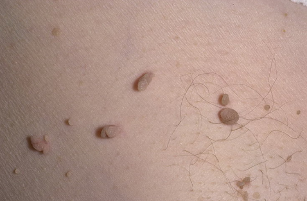Papilloma is a skin and mucous membrane infection caused by human papillomavirus.
The causative agents are the papilloma virus. Currently, more than 60 variants are known, 32 of which are recognized as pathogens.
Transmission - contact (through microtrauma of the skin), sex, perinatal (childbirth).
Appearances of papillomas

- papillomas (warts).
Most commonly found on the hands and other parts of the body. Localized injuries are more common in children and adolescents. Bone ulcers may be more common in immunocompromised patients. The incubation period is 1-6 months. The maximum number of viruses in the affected tissues is observed 6 months after infection. - Vulgar (simple) papillomas.
The causative agent is human papillomavirus (HPV). This form is combined with solid bumps with a flat surface diameter of 1 mm or more. Vulgar papillomas usually cover a large area. They can appear anywhere, but they are most common on the backs of the palms and fingers, and in children - on the knees. A papilloma is virtually unchanged for months or even years, but the process can spread rapidly. There are cases of papilloma becoming a tumor. Immune deficiency states contribute to the spread of the process. - Plantar papillomas.
The infectious agents are HPV-1 (deep form), HPV-2 (mosaic wart) and HPV-4 (minor damage). The process is small, shiny, has the characteristics of a typical papilloma, and is surrounded by protruding wheels. Occasionally, around a papilloma appear blister-like girls - mosaic warts. Plantar papillomas can be painful and difficult to walk. Their life expectancy is different. In some cases, especially in children, a variety of papillomas can disappear on their own. This type of disease usually occurs where there is pressure on the fingers or toes. Corn, unlike papillomas, has a smooth surface with a skin pattern. - Flat papillomas.
The causative agents are HPV-3 and HPV-10. They are indicated by smooth folds of normal skin color (light yellow or slightly colored). They can be round or polygonal. Most often, children develop flat papillomas, itching, inflammation of the affected area, redness and pain. - Filiform papillomas.
They occur in 50% of the population over the age of 50 in the armpits, groin, neck and around the eyes. This process begins with the formation of small yellow or slightly colored cones, which then grow into a dense elastic shape that extends to 5-6 mm in size. Papillomas may become inflamed where possible trauma occurs. They cannot disappear on their own. - Local epithelial hyperplasia (Beck's disease).
Human pepllomaviruses 13 and 32. Infectious agents were first described in American Indians. It is observed in the mucous membranes of the mouth, tongue and lips in the form of small papillary nodules. - Genital warts.
Causes of genital warts are low (6, 11), medium (31, 33, 35) and high (16, 18) human papillomas with a high risk of cancer. Viruses are sexually transmitted. The incubation period lasts from a few weeks to several months. In some cases, the damage is minimal and often goes unnoticed. Infected cells are subject to dangerous damage. In most cases, a long and widespread process is accompanied by immune deficiency.
Cervical cancer is most commonly diagnosed in women with genital warts. In most cases, regardless of the age of the patients, the viral genome is determined by DNA hybridization. The infectious agent is HPV-18. - Juvenile papillomatosis of the larynx.
The causative agents are HPV-6 and HPV-11. They are rarely registered. Papillomatosis is most often diagnosed in children under 5 years of age who are infected in the mother's birth canal. There is a characteristic increase in the vocal cords, which leads to poor speech and poor air circulation in the upper respiratory tract.
Treatment of papillomas
The same symptoms can be symptoms of different diseases, so the disease does not occur according to the textbook. Do not try to cure yourself - see your doctor.
There is currently no single international standard for the treatment of papillomas. Official instructions for treatment
includes- cytostatics (antinoplastic drugs),
- cryo laser,
- power outage.
However, they are not always effective and are accompanied by repetitions.
Other treatments for papillomas:
- For acute and coarse (simple) papillomas - surgical removal (cryodestruction, laser removal in conjunction with immune repair).
- for plantations - cryodestruction, laser and / or diathermocoagulation.
- Moses' papillomas are the most difficult to treat. When they disappear, there are signs of inflammation, especially in children.
- For flat forms - cryotherapy with immune correction.
- For filiform - diathermocoagulation.
- Cryotherapy with correction of immunity for local epithelial hyperplasia.
- Infectious cross-dysplasia, cryotherapy or diathermocoagulation, followed by immune repair.
- For genital warts - removal of warts by cryotherapy, laser excursion or diathermocoagulation and mandatory correction of the immune system.
Treatment of genital papillomas can be difficult in other sexually transmitted infections (chlamydia, bacterial vaginosis, herpes, CMV infection, etc. ). In such cases, treatment is carried out in parallel.
















































































